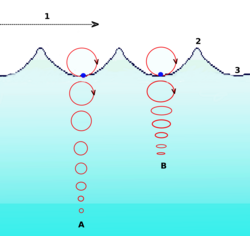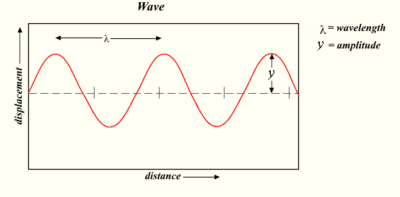Wave
2007 Schools Wikipedia Selection. Related subjects: General Physics
A wave is a disturbance that propagates through space or spacetime, often transferring energy. While a mechanical wave exists in a medium (which on deformation is capable of producing elastic restoring forces), waves of electromagnetic radiation (and probably gravitational radiation) can travel through vacuum, that is, without a medium. Waves travel and transfer energy from one point to another, with little or no permanent displacement of the particles of the medium (there is little or no associated mass transport); instead there are oscillations around fixed positions.
For many years, scientists have been trying to work out the problem of energy transfer from one place to another - especially sound and light energy.
Characteristics
Periodic waves are characterized by crests (highs) and troughs (lows), and may usually be categorized as either longitudinal or transverse. Transverse waves are those with vibrations perpendicular to the direction of the propagation of the wave; examples include waves on a string and electromagnetic waves. Longitudinal waves are those with vibrations parallel to the direction of the propagation of the wave; examples include most sound waves.
When an object bobs up and down on a ripple in a pond, it experiences an orbital trajectory because ripples are not simple transverse sinusoidal waves.
Ripples on the surface of a pond are actually a combination of transverse and longitudinal waves; therefore, the points on the surface follow orbital paths.
All waves have common behaviour under a number of standard situations. All waves can experience the following:
- Reflection – the change of direction of waves, due to hitting a reflective surface.
- Refraction – the change of direction of waves due to them entering a new medium.
- Diffraction – the circular spreading of waves that happens when the distance between waves move through an opening of equal distance.
- Interference – the superposition of two waves that come into contact with each other.
- Dispersion – the splitting up of waves by frequency.
- Rectilinear propagation – the movement of waves in straight lines.
Polarization
A wave is polarized if it can only oscillate in one direction. The polarization of a transverse wave describes the direction of oscillation, in the plane perpendicular to the direction of travel. Longitudinal waves such as sound waves do not exhibit polarization, because for these waves the direction of oscillation is along the direction of travel. A wave can be polarized by using a polarizing filter.
Examples
Examples of waves include:
- Ocean surface waves, which are perturbations that propagate through water.
- Radio waves, microwaves, infrared rays, visible light, ultraviolet rays, x-rays, and gamma rays make up electromagnetic radiation. In this case, propagation is possible without a medium, through vacuum. These electromagnetic waves travel at 299,792,458 m/s in a vacuum.
- Sound - a mechanical wave that propagates through air, liquid or solids.
- Seismic waves in earthquakes, of which there are three types, called S, P, and L.
- Gravitational waves, which are fluctuations in the gravitational field predicted by general Relativity. These waves are nonlinear, and have yet to be observed empirically.
- Inertial waves, which occur in rotating fluids and are restored by the Coriolis force.
Mathematical description
Waves can be described mathematically using a series of parameters.
The amplitude of a wave (commonly notated as A, or another letter) is a measure of the maximum disturbance in the medium during one wave cycle. In the illustration to the right, this is the maximum vertical distance between the baseline and the wave. The units of the amplitude depend on the type of wave — waves on a string have an amplitude expressed as a distance (meters), sound waves as pressure (pascals) and electromagnetic waves as the amplitude of the electric field (volts/meter). The amplitude may be constant (in which case the wave is a c.w. or continuous wave), or may vary with time and/or position. The form of the variation of amplitude is called the envelope of the wave.
The wavelength (denoted as λ) is the distance between two sequential crests (or troughs). This generally has the unit of metres; it is also commonly measured in nanometres for the optical part of the electromagnetic spectrum.
A wavenumber k can be associated with the wavelength by the relation
 .
.
The period T is the time for one complete cycle for an oscillation of a wave. The frequency f (also frequently denoted as ν) is how many periods per unit time (for example one second) and is measured in hertz. These are related by:
 .
.
In other words, the frequency and period of a wave are reciprocals of each other.
The angular frequency ω represents the frequency in terms of radians per second. It is related to the frequency by:
 .
.
There are two velocities that are associated with waves. The first is the phase velocity, which gives the rate at which the wave propagates, is given by
 .
.
The second is the group velocity, which gives the velocity at which variations in the shape of the wave's amplitude propagate through space. This is the rate at which information can be transmitted by the wave. It is given by
The wave equation
The wave equation is a differential equation that describes the evolution of a harmonic wave over time. The equation has slightly different forms depending on how the wave is transmitted, and the medium it is traveling through. Considering a one-dimensional wave that is travelling down a rope along the x-axis with velocity v and amplitude u (which generally depends on both x and t), the wave equation is
In three dimensions, this becomes
 ,
,
where  is the Laplacian.
is the Laplacian.
The velocity v will depend on both the type of wave and the medium through which it is being transmitted.
A general solution for the wave equation in one dimension was given by d'Alembert. It is
This can be viewed as two pulses travelling down the rope in opposite directions; F in the +x direction, and G in the -x direction. If we substitute for x above, replacing it with directions x, y, z, we then can describe a wave propagating in three dimensions.
The Schrödinger equation describes the wave-like behaviour of particles in quantum mechanics. Solutions of this equation are wave functions which can be used to describe the probability density of a particle. Quantum mechanics also describes particle properties that other waves, such as light and sound, have on the atomic scale and below.
Traveling waves
Waves that remain in one place are called standing waves - e.g. vibrations on a violin string. Waves that are moving are called traveling waves, and have a disturbance that varies both with time t and distance z. This can be expressed mathematically as:
where A(z,t) is the amplitude envelope of the wave, k is the wave number and φ is the phase. The phase velocity vp of this wave is given by:
where λ is the wavelength of the wave.
Propagation through strings
The speed of a wave traveling along a string (v) is directly proportional to the square root of the tension (T) over the linear density (μ):
Transmission medium
The medium that carries a wave is called a transmission medium. It can be classified into one or more of the following categories:
- A linear medium if the amplitudes of different waves at any particular point in the medium can be added.
- A bounded medium if it is finite in extent, otherwise an unbounded medium.
- A uniform medium if its physical properties are unchanged at different locations in space.
- An isotropic medium if its physical properties are the same in different directions.









